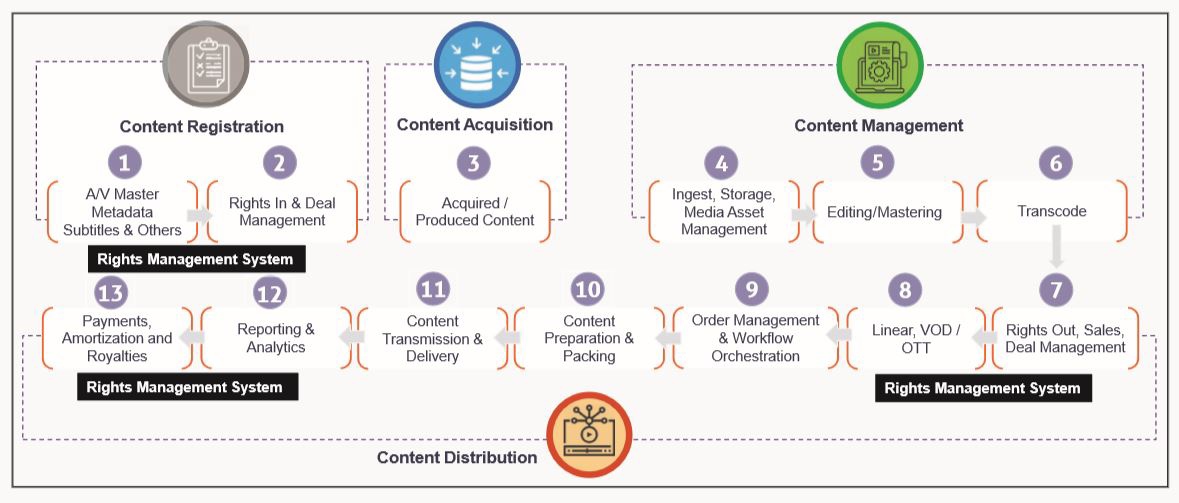Enabling Media Orgs to Streamline Content Rights for Better Monetization Opportunities
Streamlining content rights and metadata for better monetization opportunities
Gone are the days when viewers were fixated to their living rooms watching television on a schedule. Viewers now seek the freedom to watch content curated from international libraries, anywhere and on any device. Some examples include the recent Oscar winning movie ‘Parasite’, popular Japanese cartoons, international sporting events etc. The growing popularity of movies and television series highlights an important fact that great content sells beyond boundaries. Despite spending billions of dollars on content, media companies take a beating on revenues due to lapses or inefficiencies in their monetization strategies. One major factor explaining this below-par return on content investment is suboptimal rights management process. Media companies should relook at their content rights management process for effective returns.
Media companies are marred with various challenges when it comes to rights management:
- Lack of information flow: Legacy in-house systems lack integration capabilities, don’t allow companies to scale beyond a point and often end up creating islands of data. This limits data flow, which impedes real-time decision making and slows down the rights management process
- Accidental purchase of duplicate rights: Caused due to inefficient processes like lengthy contract analysis, lack of real-time inventory analysis and content licenses misreporting
- Revenue loss to artists, labels and content publishers: Rapid growth in content volume and lack of metadata standards is a double whammy. Media companies use content metadata as an important tool to manage rights throughout the content lifecycle. Thus, data discrepancies and spread of metadata across various systems affects earnings of various ecosystem players
- Legacy based systems: Existing right management systems are either on-premise that lack scalability or are moved to cloud using a ‘lift and shift’ approach that do not fully leverage the advantages of cloud
- Higher time to market: Low end-to-end automation from content deal construct to processing and delivering of the actual licensed content slows down the time-to-market
What is the matter with Metadata? |
Content metadata is used to describe the information about content assets. Media companies need to create and update the metadata for their content assets across the supply chain, which makes it easy for downstream systems to process the content. For example, a standard metadata file with the right taxonomy can be used for managing content rights, automating basic file edits and file packaging for content distribution. Moreover, when the metadata is combined with analytics, it can be used to identify content buying patterns, predict the right price of content and reduce content revenue leakages.
Metadata requirements are becoming complex as new ways of content creation, management and distribution are getting added. Media companies need to be agile while dealing with constant changes in the metadata.
Managing the rights and metadata
The skyrocketing growth of content distribution channels like VoD/OTT platforms have increased complexities of managing content rights, its metadata and ancillary assets throughout the content supply chain. There’s always a push to maximize revenues, along with a mandate to comply with dynamic contractual and regulatory obligations. Media companies need a flexible and comprehensive rights and metadata management strategy to manage and distribute content across platforms.
Figure 1 Rights management system is spread across the content value chain
Media companies need to adopt the following best practices while designing their rights and metadata management systems:
- Centralize rights and metadata systems which allow efficient access to rights information across subsystems or business units
- Reconstruct and design rights management as a core system within the content supply chains
- Recondition rights management to be in line with modern distribution channels
- Generate insights and perform analytics over the extracted content metadata in predicting content demand, mitigating revenue leakages, preventing lawsuits around content infringement etc.
- Capture and carry forward metadata created at different stages in the content supply chain such as production, quality check and cataloging. This is required to avoid wasted efforts and drive efficient execution of downstream operations. The Entertainment Industry Registry (EIDR), which adopts standardized data models, is one of the ways for content owners to hold the highest quality of content metadata
Mindtree’s Rights and Metadata Management offering
Mindtree’s modern-day rights and metadata management offering is envisioned to meet the dynamic requirements of media companies. The primary building blocks of the solution are powered by the Salesforce platform. Salesforce, along with its acquisition of Tableau and Mulesoft, provides a well-covered ecosystem for supporting rights and metadata management workflows within media companies.
Some of the advantages of using the Salesforce platform are:
- Helps in speeding up the development lifecycle by using out-of-the-box functionalities
- Provides seamless integration with enterprise systems, ERP and analytics via an API layer
- Helps to rapidly design and automate processes though visual workflows, which are a vital part in realizing the end-to-end contract management process
- Provides future-proof templatized solutions to support dynamic and evolving rights, and metadata management requirements
Figure 2. Mindtree's rights and metadata management solution building blocks powered by Salesforce
Mindtree’s rights and metadata management offering is tailored around the following tenets:
- Rapid application development – lower time-to-market by adopting rapid application development methodologies and low code solutions using the Salesforce platform
- Cross-system integration – by unifying the integration layer between rights and metadata management, and media subsystems
- Contextual AI and analytics – automate metadata extraction, compliance, subtitling, tagging, contextual search and recommendation activities using AI/ML services
- Unified enterprise data platform – using a multi-clustered shared data architecture and master data management to support a broad range of requirements like analytics, reports, dashboards and data sharing service
- Centralized transaction hub – to securely store sensitive financial data, manage cash projections and payments/ billing on the cloud
Through this offering, Mindtree envisions the following benefits for media companies:
- Speed up time-to-contract
- Handle complex deals
- Track and execute workflows
- Provide real-time insights for business, legal and other teams
- Secure information exchange between external systems
- Provide uniform storage and access of metadata
- Seamlessly handle billing and payments processes
Mindtree’s industry recognition
- Salesforce – Platinum cloud alliance partner, best cross-cloud solution partner 2016
- Zinnov Zones (2019) – Leader across digital services including legacy modernization
- ISG Provider Lens (2019) – Rising star global cloud transformation / operation services
Mindtree has delivered great outcomes for clients
- Streamlined the contract management process for an airport transport service company and automated end-to-end contract lifecycle from legacy to Salesforce platform. Migrated 67,000 contracts from Siebel and 80,000 physical contracts as a strategic initiative to enhance capabilities and ROI
- Implemented data standardization, unification, and consistency across all systems for an animal healthcare company that increased reporting efficiency and decreased lead time for reporting and business analysis. Extended the solution by implementing data stewardship to the enterprise data to enforce guidelines and controls to mitigate risks across the entire supply chain
- A multinational food manufacturer unlocked capital by 30% through cloud migration and transformation for digital marketing operations by migrating its data center from Rackspace to AWS cloud
The Mindtree Media Industry Group
Established in 2006, Mindtree’s Media Industry Group has 1000+ employees, more commonly known as Mindtree Minds. Within Media, Mindtree works with broadcasters, cable networks, publishers, advertisers, business information services, new media and gaming companies. Mindtree has executed 100+ projects for over 50 clients across North America, Europe, Middle-East and Asia Pacific regions. Mindtree is serving six of the top 10 media and publishing companies, with more than 50% of its revenue coming from digital services. Mindtree has been positioned in the Leadership Zone for Publishing, Broadcasting and Education in Zinnov Zones 2017 report.




